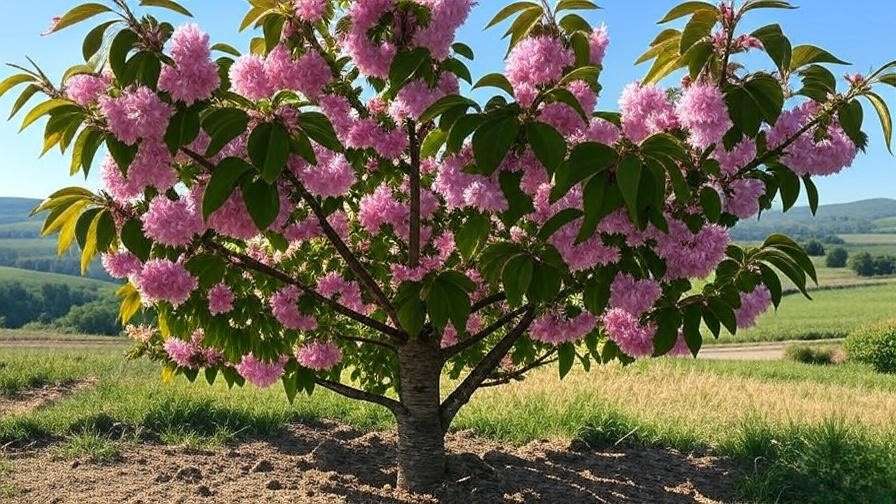Picture this: your cherished cherry tree, its delicate pink blossoms a promise of summer fruit, stands wilting under a relentless sun. Leaves curl, bark cracks, and those juicy cherries you dreamed of seem out of reach. Excessive sun exposure can turn your thriving tree into a struggling one, but fear not! This guide on how to protect cherry trees from excessive sun exposure offers practical, expert-backed solutions to keep your trees healthy and productive. Whether you’re a home gardener or an orchard owner, these strategies will ensure vibrant blooms, robust fruit, and long-lasting tree vitality. Backed by decades of horticultural expertise and research from top agricultural institutions like Cornell University, this article delivers actionable advice to save your cherry trees from the scorching sun. 🌱
Understanding the Impact of Excessive Sun Exposure on Cherry Trees ☀️
Why Cherry Trees Are Vulnerable
Cherry trees, with their thin bark and sensitive foliage, are particularly susceptible to damage from intense sunlight. Unlike thicker-barked species like oaks, cherry trees—especially young or newly planted ones—can suffer from sunscald, a condition where bark overheats, cracks, or peels. Prolonged exposure to high UV levels also causes leaf burn, reducing photosynthesis and weakening the tree’s ability to produce energy. In hot climates or during heatwaves, these issues intensify, especially in regions with high UV indices, such as the American Southwest or Mediterranean climates. Understanding these vulnerabilities is the first step to protecting your trees.
Signs Your Cherry Tree Is Suffering
Spotting sun damage early can save your tree from long-term harm. Look for these telltale signs:
- Cracked or peeling bark: Often on the south or west side of the trunk, where sun exposure is strongest.
- Discolored leaves: Yellowing, browning, or scorched leaf edges indicate overheating.
- Stunted fruit growth: Small, underdeveloped cherries or premature fruit drop.
- Premature leaf drop: Leaves falling before autumn signal stress.
Diagnostic Checklist:
- Inspect the trunk for cracks or discoloration.
- Check leaves for browning or curling.
- Monitor fruit size and drop patterns.
- Assess soil moisture to rule out drought stress.
Expert Insight: Dr. Susan Brown, a pomologist at Cornell University, notes, “Sunscald can weaken cherry trees for years, inviting pests and diseases. Early intervention is critical for tree longevity.”
The Science Behind Sun Protection for Cherry Trees 🌱
How Sunlight Affects Tree Health
Sunlight is essential for cherry trees, driving photosynthesis and fruit development. However, too much of a good thing can be harmful. Excessive UV radiation and heat stress disrupt the tree’s cellular processes, causing oxidative damage to leaves and bark. A 2019 study from UC Davis found that cherry trees exposed to temperatures above 90°F (32°C) for extended periods showed a 25% reduction in photosynthetic efficiency. Balancing sunlight exposure with protective measures ensures trees thrive without burning out.
Factors That Increase Sun Exposure Risks
Several environmental and tree-specific factors heighten the risk of sun damage:
- High temperatures: Prolonged heatwaves, especially above 85°F (29°C), stress trees.
- Drought: Dry soil reduces a tree’s ability to cool itself through transpiration.
- Reflective surfaces: Nearby pavement or light-colored structures amplify sunlight intensity.
- Tree-specific factors: Young trees, dwarf varieties, or cultivars like Bing or Rainier with thinner bark are more vulnerable.
Understanding these risks helps tailor protection strategies to your specific growing conditions.
7 Proven Strategies to Protect Cherry Trees from Excessive Sun Exposure 🛡️
Strategy 1: Apply Protective Tree Wraps or Paint
One of the most effective ways to shield cherry trees is by applying tree wraps or white latex-based tree paint to the trunk. These reflect sunlight, keeping the bark cooler and preventing sunscald. Tree wraps, made of breathable materials like burlap or vinyl, are ideal for young trees, while latex paint (diluted 1:1 with water) works well for mature trees.
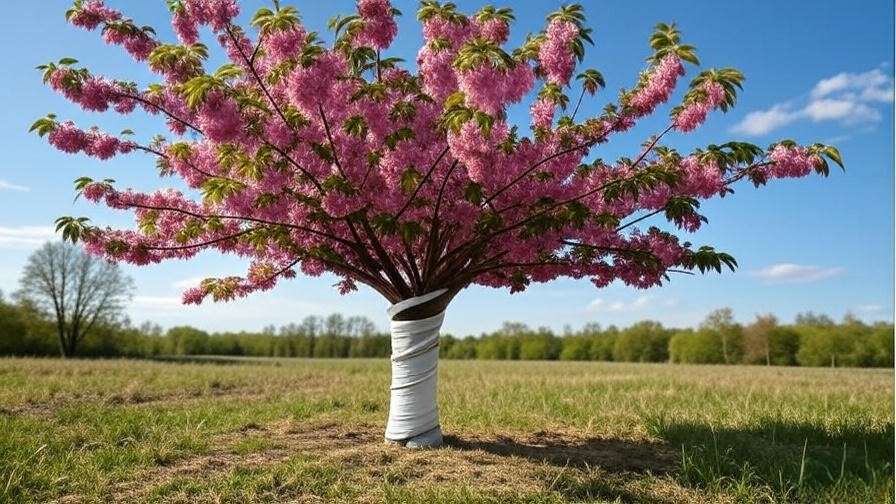
How to Apply:
- Clean the trunk to remove debris.
- For wraps, spiral the material from the base to the first branches, overlapping slightly.
- For paint, use a brush to apply an even coat to the south- and west-facing sides.
- Reapply paint every 1-2 years; check wraps annually for wear.
Tip: Opt for eco-friendly, breathable wraps to avoid trapping moisture, which can lead to fungal issues.
Strategy 2: Use Shade Cloths or Canopy Covers
Shade cloths are a game-changer for protecting cherry trees from intense sunlight. These lightweight, UV-resistant fabrics reduce direct sun exposure while allowing air circulation and light penetration. A 30-50% shade cloth is ideal for cherry trees, balancing protection with photosynthesis needs.
Installation Guide:
- Measure the tree’s canopy to select an appropriately sized cloth.
- Secure the cloth over the tree using stakes or a frame, ensuring it doesn’t touch the foliage.
- Install in early summer before peak heat; remove in fall to maximize light.
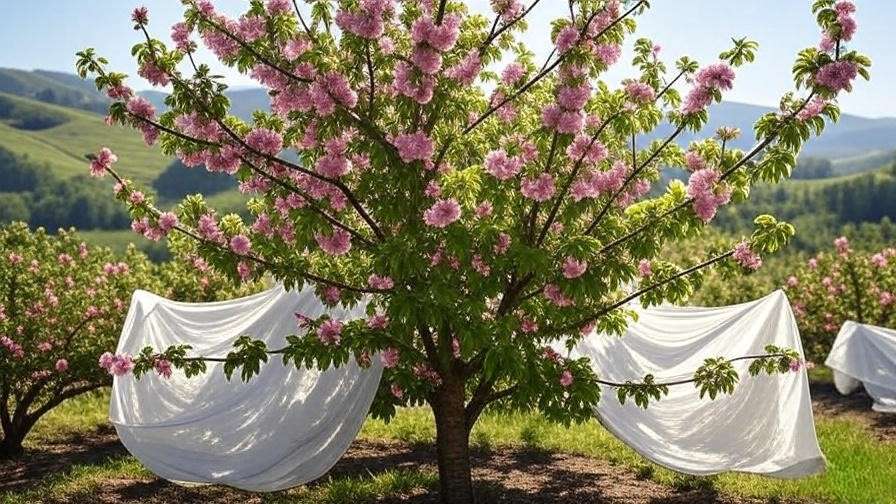
Example: A Michigan orchard reported an 80% reduction in sunscald after installing 40% shade cloths over their cherry trees, boosting fruit quality and yield.
Strategy 3: Optimize Watering Practices
Consistent moisture is critical for mitigating heat stress. Cherry trees under sun stress lose water faster through transpiration, so proper irrigation is key. Drip irrigation or soaker hoses deliver water directly to the root zone, reducing evaporation.
Watering Schedule:
- Young trees: 5-10 gallons weekly, adjusted for rainfall.
- Mature trees: 10-15 gallons weekly during hot, dry periods.
- Timing: Water early in the morning to maximize absorption and minimize fungal risks.
Expert Insight: A 2020 study from Oregon State University found that well-hydrated cherry trees showed 30% less leaf burn than under-watered ones, highlighting irrigation’s role in sun protection.
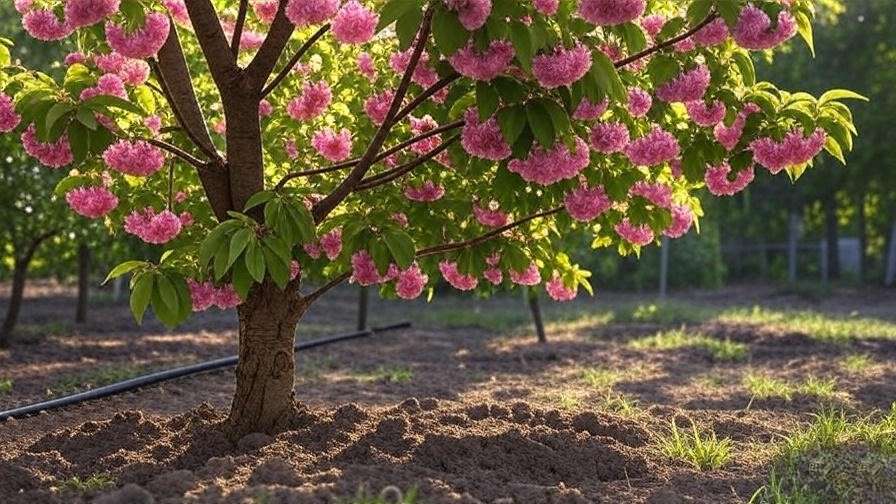
Strategy 4: Mulch for Soil and Root Protection
Organic mulch, such as wood chips, straw, or compost, regulates soil temperature and retains moisture, creating a cooler root environment. This helps cherry trees cope with heat stress and maintain vigor.
Mulching Guide:
- Apply a 2-4 inch layer of mulch in a 3-foot radius around the tree base.
- Keep mulch 2-3 inches away from the trunk to prevent rot.
- Replenish annually to maintain depth.
Tip: Use composted mulch to enrich soil nutrients, supporting overall tree health.
Strategy 5: Prune Strategically to Balance Sunlight
Pruning is a powerful tool to manage sunlight exposure and improve air circulation, reducing the risk of overheating in dense canopies. Strategic pruning opens up the tree’s structure, allowing light to penetrate evenly while preventing excessive exposure to vulnerable branches.
Pruning Guidelines:
- Timing: Prune in late winter or early spring before bud break to minimize stress.
- Technique: Remove crowded branches, crossing limbs, and dead wood to enhance airflow.
- Focus: Thin the canopy to allow dappled sunlight, avoiding direct exposure to the trunk or lower branches.
- Tools: Use clean, sharp pruning shears or loppers to make precise cuts.
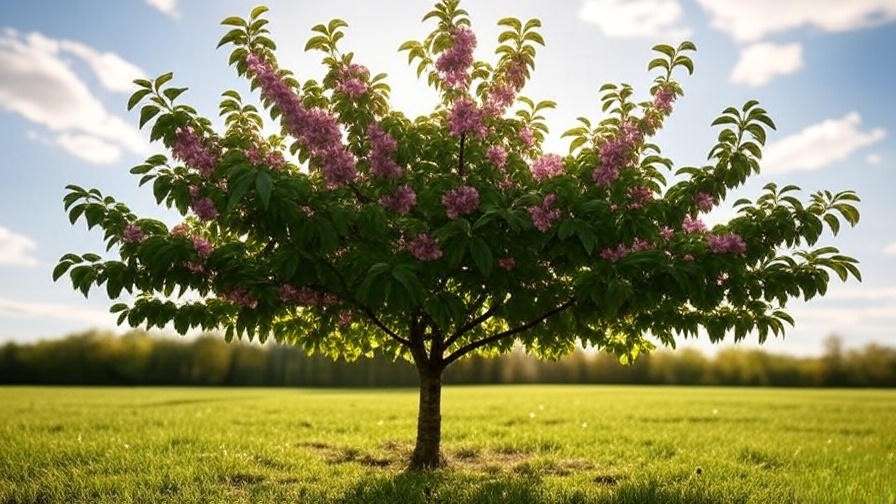
Visual Aid: A diagram illustrating proper pruning cuts for cherry trees can help readers visualize the process. For example, cut at a 45-degree angle just above a bud to encourage healthy growth.
Expert Insight: According to the University of California Cooperative Extension, proper pruning can reduce canopy temperature by up to 5°F, significantly lowering sun stress.
Strategy 6: Plant Companion Trees or Shrubs
Creating natural shade with companion planting is an eco-friendly way to protect cherry trees. Taller trees or shrubs positioned to the south or west can cast shade during peak sun hours, reducing direct exposure.
Recommended Companions:
- Maples or dogwoods: Provide dappled shade without competing heavily for nutrients.
- Low-growing shrubs: Options like lavender or rosemary add aesthetic value and partial shade.
- Placement: Plant companions 10-15 feet away to avoid root competition but close enough to cast shade.
Example: A Washington state gardener reported healthier cherry trees after planting a row of dogwoods to shield them from afternoon sun, noting fewer instances of leaf burn and better fruit set.
Tip: Choose companion plants with similar soil and water needs to ensure harmony in your garden.
Strategy 7: Monitor and Adjust for Seasonal Changes
Protecting cherry trees from sun exposure is an ongoing process that requires vigilance. Weather patterns, such as unexpected heatwaves or prolonged drought, can change a tree’s needs. Regular monitoring ensures your protection strategies remain effective.
Monitoring Tips:
- Check sun intensity: Use a UV sensor or weather app to track UV index and temperature spikes.
- Inspect tree health: Look for signs of stress (e.g., wilting leaves, cracked bark) weekly during summer.
- Adjust protections: Tighten shade cloths, reapply tree paint, or increase watering as needed.
Expert Insight: Horticulturist Dr. Linda Chalker-Scott recommends seasonal adjustments, noting, “Adapting to weather changes can mean the difference between a struggling tree and a thriving one.”
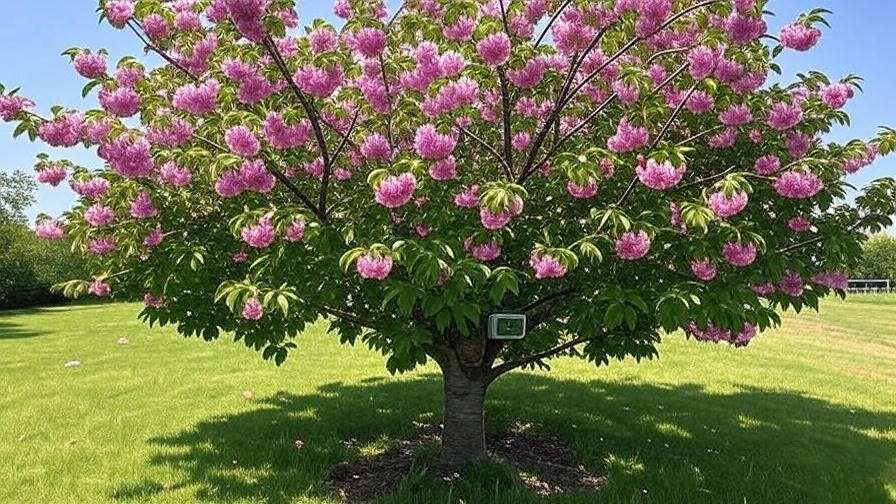
Common Mistakes to Avoid When Protecting Cherry Trees 🚫
Even well-intentioned gardeners can make mistakes that harm cherry trees. Avoid these pitfalls to ensure effective sun protection:
- Over-mulching: Piling mulch against the trunk can trap moisture and cause rot. Keep mulch 2-3 inches away from the base.
- Using dark-colored wraps: Dark materials absorb heat, worsening sun damage. Stick to white or reflective wraps.
- Improper pruning: Cutting too much or at the wrong time can expose sensitive bark or stress the tree. Follow seasonal guidelines.
- Neglecting maintenance: Failing to check shade cloths or tree wraps for wear can reduce their effectiveness.
Do’s and Don’ts Table:
| Do | Don’t |
|---|---|
| Use white, breathable tree wraps | Use dark or non-breathable wraps |
| Apply mulch in a 2-4 inch layer | Pile mulch against the trunk |
| Prune in late winter/early spring | Prune during peak summer heat |
| Monitor tree health weekly | Ignore signs of sun stress |
Long-Term Benefits of Protecting Cherry Trees from Sun Exposure 🌿
Implementing these strategies does more than prevent immediate sun damage—it sets your cherry trees up for long-term success. Protected trees produce:
- Healthier fruit: Studies from Michigan State University show a 20% increase in cherry yield with proper sun protection.
- Stronger trees: Reduced stress strengthens resistance to pests and diseases like powdery mildew.
- Longer lifespan: Healthy bark and foliage extend a tree’s productive years.
Additionally, these practices support environmental sustainability by conserving water, supporting pollinators like bees, and reducing the need for chemical treatments. A thriving cherry tree enhances your garden’s beauty and ecological value.
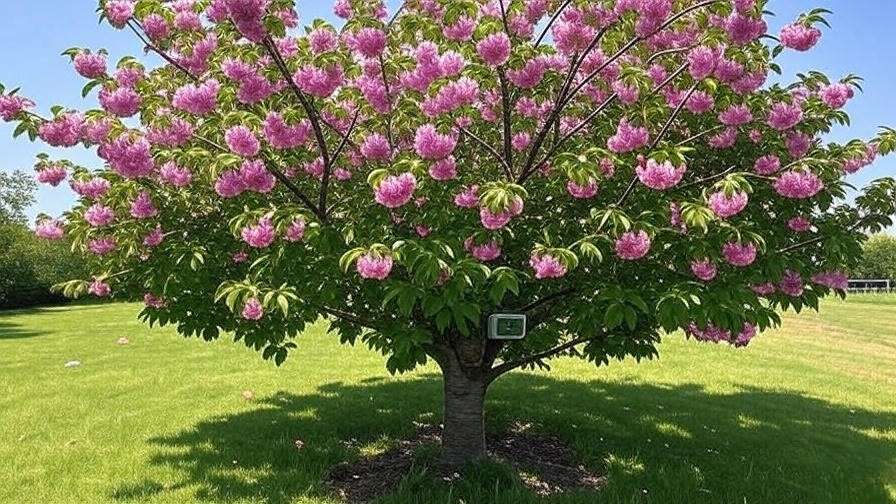
Tools and Products for Sun Protection 🛠️
Investing in the right tools makes sun protection easier and more effective. Here are top recommendations:
- UV-resistant shade cloths: Look for 30-50% shade options from brands like Agfabric or Coolaroo. Pros: Durable, reusable; Cons: Initial cost can be high.
- Eco-friendly tree paint: Products like IV Organic White Tree Guard are safe and effective. Pros: Easy to apply, long-lasting; Cons: Requires reapplication every 1-2 years.
- Moisture meters: Devices like the XLUX Soil Moisture Meter help monitor soil hydration. Pros: Affordable, precise; Cons: Batteries may need replacing.
DIY Alternative: For budget-conscious gardeners, mix equal parts white interior latex paint and water for a cost-effective tree paint solution.
FAQs About Protecting Cherry Trees from Excessive Sun Exposure ❓
Q1: How can I tell if my cherry tree is getting too much sun?
A: Look for cracked bark, scorched leaves, or premature fruit drop. Regular inspections during summer can catch issues early.
Q2: Are certain cherry tree varieties more sun-tolerant?
A: Yes, varieties like Stella or Lapins have thicker bark, offering some natural resistance, but all cherries benefit from sun protection.
Q3: Can I use household paint to protect my tree’s trunk?
A: No, household paint may contain harmful chemicals. Use water-based, non-toxic latex paint designed for trees.
Q4: How often should I check my shade cloth for wear and tear?
A: Inspect shade cloths monthly during summer for rips or fading, and replace every 2-3 years for optimal protection.
Q5: What’s the best time of year to apply sun protection measures?
A: Late spring to early summer is ideal for installing shade cloths and wraps, while tree paint can be applied year-round as needed.
Conclusion 🌸
Protecting your cherry trees from excessive sun exposure is a rewarding investment in their health and productivity. By applying tree wraps, using shade cloths, optimizing watering, mulching wisely, pruning strategically, planting companions, and monitoring seasonal changes, you can shield your trees from the sun’s harsh rays. These seven proven strategies, grounded in horticultural science and real-world success, empower you to nurture vibrant, fruit-laden cherry trees for years to come. Start with one strategy today—your trees will thank you with lush foliage and bountiful harvests! Share your experiences in the comments or explore our related articles on cherry tree care for more tips. 🌳

